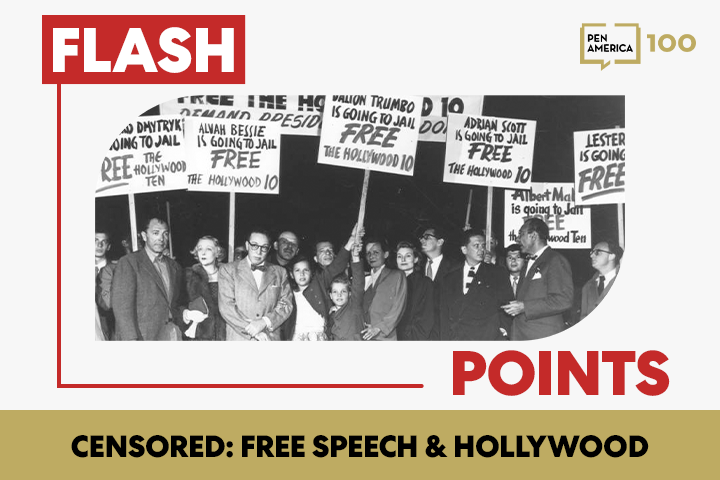Censored: Free Speech & Hollywood

From women’s bodies on-screen to interracial romance, tensions have existed between what society deems appropriate and First Amendment rights to show controversial images and representations. Throughout all of film’s history, questions over who has access to filmmaking, to studios and budgets has been a form of de-facto silencing of certain voices and stories. By reviewing legislation and court decisions, exploring blacklisted artists, and the opening up of representation in the late twentieth century, this humanities discussion will explore contestations around representing controversial subjects–disfavored political ideologies, women’s sexuality, interracial romance, and more–and the dangers of state-driven attempts to define ‘acceptable’ topics for creative expression.
DOWNLOAD OUR DISCUSSION GUIDE AS A PDF
Video Highlights
- 3:25 Listen to Gillian Wallace Horvat introduce the format of the panel.
- 4:00 Listen to Jeremy Geltzer discuss how filmmakers pushed the boundaries of censorship from the beginning of the genre, and how a string of anti-censorship court decisions in the 1950s and 1960s led to more freedom for filmmakers.
- 19:10 Listen to Gerald Horne discuss the formation of the Hollywood blacklist in the 1940s and how it was the result of labor struggles that negatively affect working conditions in the industry to this day.
- 26:58 Listen to Maya Montañez Smukler discuss how the studio system enforced societal sexism and how BIPOC women directors were affected especially adversely, but how arthouse films of the 1970s made more room for these directors.
- 56:55 Listen to Horne explain why the Hollywood blacklist was different from present-day “cancel culture” because the cancellation of figures such as Harvey Weinstein is justified whereas the blacklisting of workers in the 1940s was not because it censored constitutionally-guaranteed free speech rather than criminal actions.
In the McCarthy era of the 1950’s, alleged communists were forced out of Hollywood through blacklists. As a result, the film industry saw self-censorship of artistic expression increase in a manner that still impacts the Hollywood we know today. Watch the short video below to learn about how the Hollywood Ten were targeted in the Red Scare.
Contributing Scholars
Gillian Wallace Horvat is a L.A.-based writer and filmmaker. Her debut feature I BLAME SOCIETY was named “One of the Best Films of 2021” by New York Magazine.
Jeremy Geltzer is an attorney, author, and professor based in Los Angeles. He is the author of Dirty Words & Filthy Pictures: Film and the First Amendment (The University of Texas Press).
Gerald Horne holds the Moores Professorship of History and African American Studies at the University of Houston. His research has addressed issues of racism in a variety of relations involving labor, politics, civil rights, international relations and war. He has also written extensively about the film industry.
Maya Montañez Smukler heads the UCLA Film & Television Archive Research and Study Center. Her book Liberating Hollywood: Women Directors and the Feminist Reform of 1970s American Cinema (Rutgers University Press) is the recipient of the Theater Library Association’s Richard Wall Memorial Award.
From the PEN archives
- “48th PEN International Congress – Censorship in the USA” with Margaret Atwood, Robert Bernstein, Rose Styron, Gay Talese, Charles Rembar, Barbara Parker, Kurt Vonnegut (1986)
- “1000 Words: The Power of Visual Storytelling” with David Polonsky, Emmanuel Guibert, Jonathan Ames, and Shaun Tan (2009)
- “A Blacklisted Screenwriter on American Surveillance” with Walter Bernstein (2013)
- “Life in the Panopticon: Thoughts on Freedom in an Era of Pervasive Surveillance” with Catherine Crump, Julian Sanchez, Gabriela Adamesteanu, Ken MacLeod, and Ludmila Ulitskaya (2012)
- “Something to Hide: Writers Against the Surveillance State” with Irakli Kakabadze, Wallace Shawn, Chenjerai Hove, Francine Prose, György Dragomán, Ingo Schulze, Péter Esterháy, and Anthony Romero (2008)
For a Deeper Dive
- Dirty Words & Filthy Pictures: Film and the First Amendment by Jeremy Geltzer
- The Final Victim of the Blacklist: John Howard Lawson, Dean of the Hollywood Ten, 2005 by Gerald Horne
- Class Struggle in Hollywood, 1930-1950: Moguls, Mobsters, Stars, Reds and Trade Unionists by Gerald Horne
- Liberating Hollywood: Women Directors and the Feminist Reform of 1970s American Cinema by Maya Montañez Smukler
